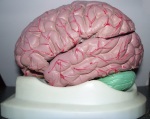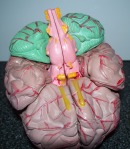Like many people, I grew up knowing very little about how the human body works. Not much more than a toddler’s ability to point out basic anatomy is required to get through our school system, so that’s about all I learned. My RA diagnosis a few years ago gave me a quick crash course, though, and I found myself fascinated with the intricacies of anatomy and physiology.
I mentioned previously that I would be looking for materials so that my children don’t grow up as ignorant about this topic as I did. The things that we’ve found the most interesting and informative are:
Lyrical Life Science:  Volume three is The Human Body. Fun songs, set to familiar tunes, make it easy to learn the basics about the different body systems. If you click the link, you can listen to some samples of the music. My favorite, ironically enough, is the digestive system; unfortunately that one doesn’t have an online sample. The first two volumes are good, too, but we started with the third and went back to pick up the others. This is written at the junior high level, so it’s very understandable. I highly recommend it.
Volume three is The Human Body. Fun songs, set to familiar tunes, make it easy to learn the basics about the different body systems. If you click the link, you can listen to some samples of the music. My favorite, ironically enough, is the digestive system; unfortunately that one doesn’t have an online sample. The first two volumes are good, too, but we started with the third and went back to pick up the others. This is written at the junior high level, so it’s very understandable. I highly recommend it.
For a good overview of the basics, I think that’s enough. One of my daughters wants to become a paramedic, and has taken the initiative to learn more. She’s studying AP biology – which is anatomy & physiology – and I can’t wait for her to finish the course so I can have the textbook. She’s also following a couple blogs (here and here) to learn more, but that’s more about EMS than anatomy.
Beyond the basics, and to make things more interesting, I’ve added some visual aids.
 Skeleton: Being a hands-on person, I’d much rather have a three-dimensional object to study than just a drawing to view. We can read (and sing) about the skeleton, number of bones, and many of the bone names, but it’s different to be able to get a good look at how the individual bones are shaped and where they’re located. We can take the skeleton off his stand and put him in one of the chairs to sit with the family. My kids are getting a much better grasp (no pun intended) on the bones of the body than they’d get if we just looked at pictures in a book. I really wanted a skeleton with muscles attached, but one look at the price on those models put an end to that idea.
Skeleton: Being a hands-on person, I’d much rather have a three-dimensional object to study than just a drawing to view. We can read (and sing) about the skeleton, number of bones, and many of the bone names, but it’s different to be able to get a good look at how the individual bones are shaped and where they’re located. We can take the skeleton off his stand and put him in one of the chairs to sit with the family. My kids are getting a much better grasp (no pun intended) on the bones of the body than they’d get if we just looked at pictures in a book. I really wanted a skeleton with muscles attached, but one look at the price on those models put an end to that idea.
 Torso: Another of those hands-on things (since we don’t have the option of cutting bodies open to peek inside) is a torso. There is a huge variation in types and prices, and I found a decent one that gives us the option of male/female/neutral (because guests are okay with a skeleton in my bathroom, but an anatomically correct gendered-torso in the living room might be a bit much for even the most open-minded of my friends).
Torso: Another of those hands-on things (since we don’t have the option of cutting bodies open to peek inside) is a torso. There is a huge variation in types and prices, and I found a decent one that gives us the option of male/female/neutral (because guests are okay with a skeleton in my bathroom, but an anatomically correct gendered-torso in the living room might be a bit much for even the most open-minded of my friends).

 Brain: We also have a brain model. It can be taken apart to get a good view of the different sections. My kids roll their eyes at having to actually learn this stuff, but all their friends are jealous. It’s pretty funny to have company visit and someone suddenly ask, “Is that a brain?” then pick it up and start taking it apart to get a good look at everything.
Brain: We also have a brain model. It can be taken apart to get a good view of the different sections. My kids roll their eyes at having to actually learn this stuff, but all their friends are jealous. It’s pretty funny to have company visit and someone suddenly ask, “Is that a brain?” then pick it up and start taking it apart to get a good look at everything.
Rotator cuff: I think any joint would work to illustrate how muscles and tendons all fit together and attach to bones.
We also do a few dissections: lungs are fun, but we’ve done heart and kidneys, too. I want my kids to have a good basic understanding of how their bodies work. This approach seems to be making that happen.
Anything you think would be worthwhile to add?


In y A&P class we have used 2 things that I think are awesome. One is a computer program called anatomy and physiology revealed that lets you dissect a real human on your computer. You can vary the level of depth you are at so you can focus on bones, muscles, nerves, whatever you want to. It is fascinating and before my class even began I would sit and look around for hours. The other is a book called A Brief Atlas of the Human Body. It shows real human bones and muscles and kind of goes in layers too. It’s really helping me with my anatomy, that is for sure! If you want more info on the book or computer thing let me know.
I’d love info on both. Thank you.
I always loved looking at the color plates depicting human anatomy in the encyclopedias at the library. Like you, I thought it was all just fascinating, and still do. One book I’ve longed to have is my own Gray’s Anatomy–as an artist, understanding how the body under the skin looks and functions is important to rendering it correctly on paper or canvas. Add simple fascination and it’s a good reason to get a copy. I’ve never gotten one, though, as it was simply too expensive.
Socks, your kids are lucky their mom is so determined that they know and understand how their bodies work. You’re an excellent teacher. 🙂
I didn’t know you were an artist! I knew you’re a writer, but hadn’t known your talents were so diverse. There’s a paperback Gray’s Anatomy for $10 that might tide you over until you find a good hardback copy (I love used book sales). Another thing you might like is a coloring book that my daughter is using: http://www.amazon.com/Anatomy-Coloring-Book-Wynn-Kapit/dp/0805350861/ref=sr_1_1?s=books&ie=UTF8&qid=1317883460&sr=1-1
Anatomy and Physiology Revealed Version 2.0 CD [CD-ROM]
If you go to amazon.com you can see what it looks like. Sort of expensive but I love it.
The other one is A BRIEF ATLAS OF THE HUMAN BODY – SECOND EDITION [Paperback]
Matt Hutchinson (Author). They also have this at amazon and it is way less than I paid for mine at my college bookstore (whish I had thought to check amazon before!)
Both are excellent but I think the computer program is better because you can basically do an autopsy on your computer so you are in control of what level of the body you are in.
Thank you. I’d looked at Amazon, but wasn’t sure which ones since multiple items have the same title. *gasp* I’d forgotten how expensive college textbooks are. For the software, It looks like version 2 is a cd, and version 3 just came out as a dvd. Thank you, Tori. I appreciate your help.